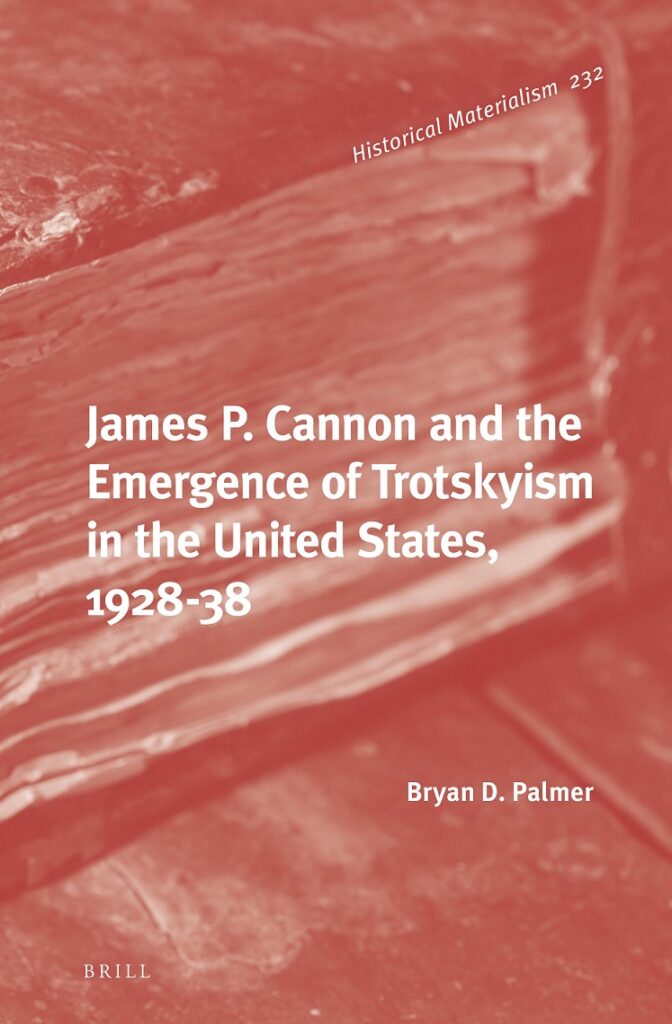Biblioteca / 2020-2029
Bryan Palmer. James P. Cannon and the Emergence of Trotskyism in the United States, 1928-38.
Leiden: Brill, 2021.
xxii, 1208 páginas.
Contents
Preface and Acknowledgments
Introduction: James P. Cannon and the ‘Prince’s Favors’
1 – Hope and the Dog Days
2 – Historiography’s House of Mirrors
3 – Mirror Image Refusals
4 – Analytic Alternative
5 – Cannon and the History of American Trotskyism
1 – An American Left Opposition
1 – Exile off Main Street
2 – Stalinism Consolidating
3 – Stalinist Slow Dancing: Guile
4 – Picking up the Pace: Gangsterism
5 – Recruiting the American Left Opposition: Three Phases
6 – Cannon: Caretaker of the Original Left Opposition Cadre
7 – Recruitment’s Second Phase: Stalinism’s Heavy Hand
8 – ‘An Army of a Million People’: Hungarians, Italians, Finns, and Immigrant Birth Controllers
9 – A Publication Program
10 – The Founding of the Communist League of America (Opposition)
2 – Dog Days
1 – Downturn: Economic Depression
2 – ‘Left Turn’: Revolutionary Politics and the Third Period
3 – Dimensions of Cannon’s Crisis: Material Being
4 – Dimensions of Cannon’s Crisis: Reconstituted Families and Domestic Complications
5 – Dimensions of Cannon’s Crisis: Rose Karsner’s Break-Down
6 – Cannon’s Collapsing World: The Personal Becomes Political
7 – The Weisbord Whirlwind
8 – Branch Bickerings: New York Cliquism and Youth Recruits
9 – Factional Waystation: June 1932, National Committee Plenum
10 – Factionalism Internationalized: The Turn to Europe
11 – International Intervention
12 – Dog Days Denouement: New Turns
13 – Internal Ironies
3 – Daylight: Analysis and Action
1 – 1933–34: Past, Present, and Future
2 – Context: Revival/Reorientation
3 – The Long and Trying March Back to a Labor Party Perspective
4 – Black Oppression in America: National Self-Determination vs. The Revolutionary Struggle for Equality
5 – The Momentum of Mobilizations: Unemployed and Labor Defense Work
6 – Miner Militants: Cannon’s ‘Bona Fide Proletarians’
7 – B.J. Field: A Napoleon among New York’s French Chefs
8 – Dawn of a New Left Opposition Day
4 – Minneapolis Militants
1 – General Strike
2 – Class Relations in Minneapolis
3 – Trotskyists among the Teamsters: Propagandistic Old Moles
4 – January Thaw; February Cold Snap: The Coal Yards on Strike
5 – Lessons of the Coal Yards Strike
6 – Strike Preparations: Unemployed Agitations and Industrial Unionism
7 – Overcoming ‘Bureaucratic Obstacles’
8 – The Ladies’/Women’s Auxiliary
9 – Rebel Outpost: 1900 Chicago Avenue
10 – The Tribune Alley Plot and the Battle of Deputies Run
11 – May 1934: Settlement Secured; Victory Postponed
12 – Stalinist Slurs
13 – Farmer-Labor Two Class Hybrid vs. Class Struggle Perspective
14 – Interlude
15 – Toward the July Days
16 – A Strike Declared; A Plot Exposed
17 – Bloody Friday
18 – Labor’s Martyr: Henry B. Ness
19 – Martial Law/Red Scare
20 – Olson: The Defective ‘Merits’ of a Progressive Pragmatism
21 – Standing Fast: Satire and Solidarity
22 – Mediation’s Meanderings
23 – Sudden and Unexpected Victory
5 – Entryism
1 – 1934: Militancy and Marginalization’s Movement
2 – The French Turn
3 – Cannon, Trotsky, and the Preparatory Ground of Entryism: Transcending the ‘Organic Unity’ Imbroglio
4 – Fusion with the Musteites
5 – Building the Party amid Fusion’s Fallouts
6 – Anticipating the French Turn
7 – Americanizing the French Turn: Factions and Combinations
8 – The Intensification of Oehlerite Sectarianism
9 – Ousting the Oehlerites
10 – Socialist Party Schisms and Workers Party Entry
11 – Prelude to Entry: Cannon in Harness and Muste’s Conversions
12 – Entryism & Subordination
13 – A Farmer-Labor Detour and the Return of the Oehlerite Repressed
14 – Entry Proclaimed
15 – Cannon in California: The ‘Foot Loose Rebel’ and the Agitational Road
16 – Entryist Estrangement
17 – The Return of the Prodigal Agitator
18 – Reaction from Above
19 – The End of Entry
20 – Assessing the French Turn in America
6 – Trials, Tragedies, and Trade Unions
1 – 1937’s Imperative: Assimilating Revolution’s Recruits
2 – The Origins of the American Committee for the Defense of Leon Trotsky
3 – The Non-partisan Origins of Trotsky’s Defense
4 – Dancing with Dewey
5 – Trotsky’s Testimony
6 – Carleton Beals and Stalinism at Work in the Preliminary Sub-commission
7 – Delimitation by Default
8 – Social-Democratic Delimitation
9 – Brand Barcelona on Centrist Foreheads: Trotskyism and the Spanish Civil War
10 – Trotskyism Finds its ‘Sea Legs’: Cannon and the Maritime Federation of the Pacific
11 – Frame-Up in Minneapolis: Who Killed Patrick J. Corcoran?
12 – Trotskyism on the Line: Footholds in Mass Production and the CIO
Conclusion: Party/International
Selected References
